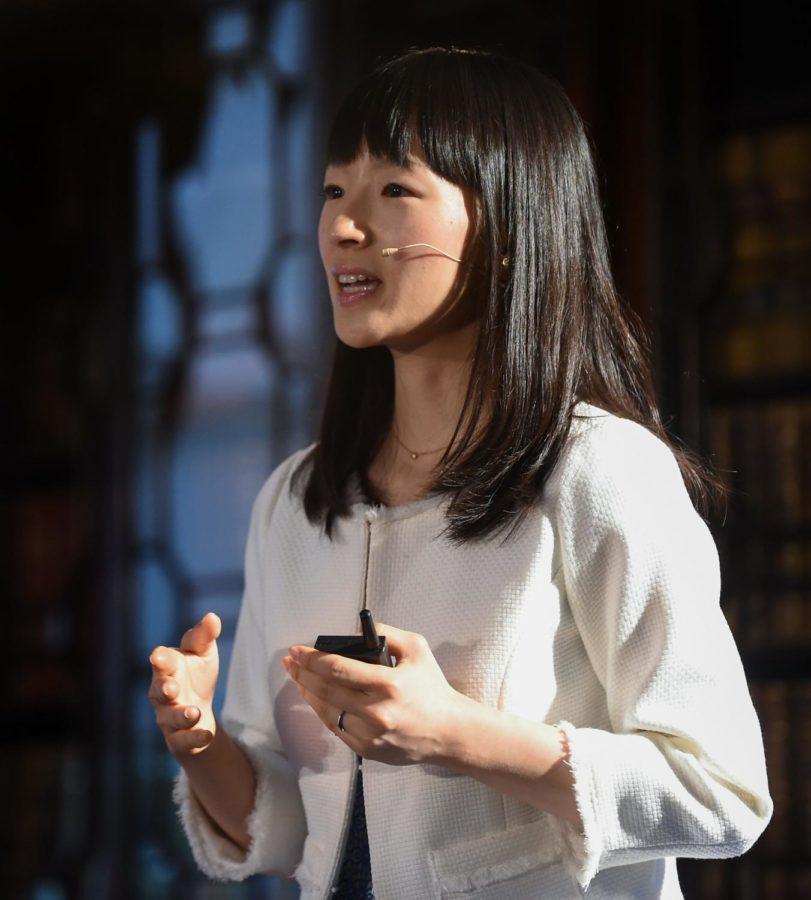Kondo criticisms highlight Asian student experiences
Marie Kondo
March 19, 2019
As Netflix’s “Tidying Up with Marie Kondo,” has swept the nation, Kondo has been the subject of both praise and criticism that has invoked colonial stereotypes and prejudices, and these words have reflected experiences of some Iowa State students.
Kondo became the subject of controversy when many people misinterpreted her advice from an episode of her show, in which critics claimed that she advised people to keep “only 30 books.”
Kondo has repeatedly stated that her method does not have numerical recommendations. This number was a reference to how many she personally keeps. Regardless, many people attacked Kondo through social media and traditional newspaper opinion pages.
One of them was Anakana Schofield, an Irish-Canadian writer. Schofield went on a tirade on Twitter, claiming it was an “uprising against Konmari.” She later wrote a piece for the British newspaper, the Guardian. In some time since this incident, Schofield has locked her Twitter account.
In her piece for the Guardian, Schofield referred to aspects of Kondo’s methods, including “waking up” books, as “woo-woo nonsense” and stated that one wakes up books by opening and reading them “not tap it with fairy finger motions.”
Not all of the criticism seemed to come from this specific incident, however. Barbara Ehrenreich, another writer, also took to Twitter to air her thoughts about Kondo’s new show.
“I will be convinced that America is not in decline only when our de-cluttering guru Marie Kondo learns to speak English,” wrote the author of “Nickel and Dimed” and “Natural Causes.”
She doubled down on this tweet in a second tweet where she says she is not bothered that Kondo “doesn’t speak English to her huge American audience,” but she dug deeper on her point that it does signal that America is “in decline as a superpower.” In a third tweet, she tried to pass the incident off as an “[attempt] at subtle humor,” which backfired.
Other opinion pieces and news articles have criticized these critics, calling them racist and embodying aspects of racism and Orientalism, a term most commonly associated with the work of Edward Said, who was a professor of literature at Columbia University.
One piece, “The Not-So-Subtle Racism Behind the Marie Kondo Criticism,” by Muqing Zhang in Paper Magazine broke down the language of Kondo’s critics into the duality that is the stereotypical view of Asian people as something to fetishize and something to fear.
“Once Kondo was no longer an exoticism’s site of pleasure and exploitation for white people to experience their Orientalist fantasies, she became the other Orientalist trope — the yellow peril threat to white people’s insecurity over their destructive capitalist consumption,” Zhang wrote.
Tao Wang, an assistant professor of history at Iowa State, said Orientalist stereotypes influence U.S. foreign policy towards countries of Asia, specifically ones that were enemies, such as North Korea and China.
Wang mentioned the “yellow peril” stereotype in response to the policies of the U.S. These prejudices had already been in the national consciousness by the 1950s. This stereotype has existed for centuries and become prominent in the American West during periods of heavy immigration from China and Japan in the late 19th century.
The experience of Asian students at Iowa State and how they see themselves on campus and at a national level has echoed the concerns of people of Asian descent nationally.
Saaya Ito, president of the Japanese Students Association on campus and a senior in marketing, shared a few stories of friends who were both international students and Asian American students.
Ito wrote a few of these experiences in an email, and they included stories about her international friends being stared at when their names are said during roll call, feeling threatened by bigger men at the gym and people avoiding sitting near them in class.
As for her Asian American friends, they often find themselves isolated, especially those who grew up in parts of the country with low Asian populations, the Midwest being the example offered. They look forward to going to universities because there is a chance that they will meet people like them.
However, they found these prospects to be underwhelming or different than they imagined. After meeting international students, Ito wrote that they often felt like they could not connect with them. They could not find common ground with these students, despite having similar heritages and this left them feeling isolated once again.
Rahul Namboori, President of the Indian Students’ Association and a Junior in Management Information Systems, provided another look into the experiences of Asian students.
Namboori was born in India but moved to Iowa during third grade. Growing up, he “pushed himself” into American culture but was “still proud of [his] culture.” He said that his parents raised him to embrace his Indian identity. However, he also said that he found that he had split himself into two different personalities, a public and private persona.
He explained that he acted differently based on where he was. At home he would embrace his background whereas, in public, he might embody a more “American” identity, though he said he wasn’t sure why.
On the issue of racism and Orientalism, he said he has not “experienced anything personally racist on campus. People seem to just keep it to themselves. It seems more prevalent online where it is more faceless.”
Namboori repeatedly stressed that his experience is in no way representative of everyone in his organization or on campus in general.
Raahym Rasul, a junior in supply chain management and vice president of the Pakistan Student Association, shared his experiences in an interview as well.
Rasul is an international student from Pakistan and has lived there most of his life. Rasul agreed with Namboori that he had not experienced any racism directed towards him personally but he notices when he is being treated differently because of his background.
He explained it as a “gut-feeling” when interacting with people. Rasul has traveled a lot while attending Iowa State and says there is a different dynamic between the Midwest and the coasts.
“People get used to you faster on the coasts,” Rasul said.
He mentioned that it just takes people in the Midwest a little more time to get used to international students.
Rasul mentioned instances where he would interview for jobs and internships, and the tone and mannerisms of the interviewer would change as soon as he mentioned where he was from. Rasul would notice this change and think, “I’m not getting this job.”
Rasul said that international students, from Asia especially, are nothing to fear. Contrary to the orientalist notions of the West, he does not think they are going to come in and change the culture of the U.S. He said that international students played a key role in the U.S. economy, contributing $39 billion last year, according to a study by the Association of international Educators.

















